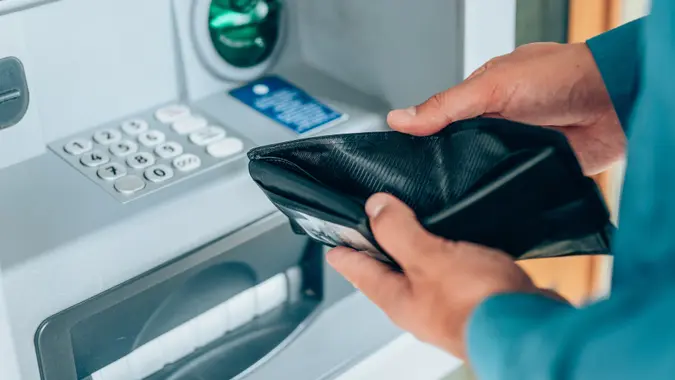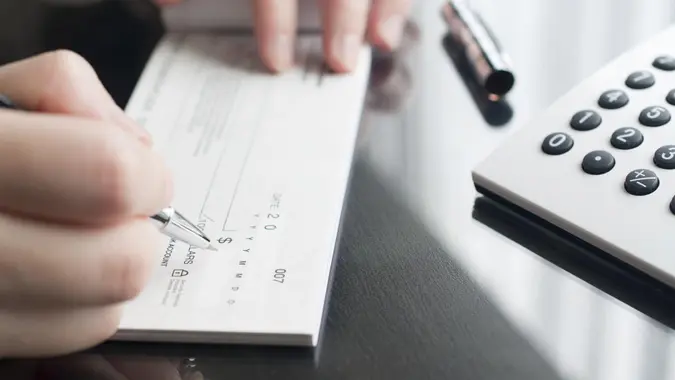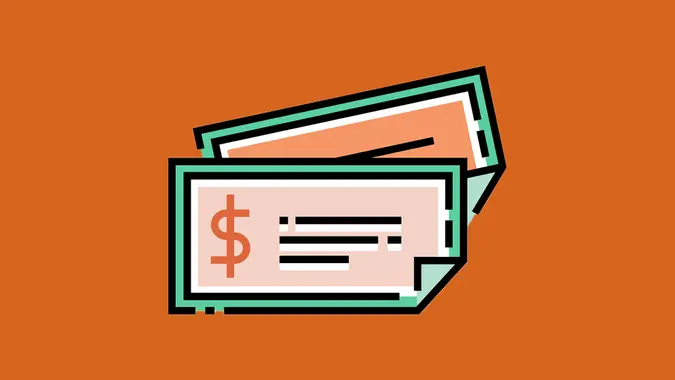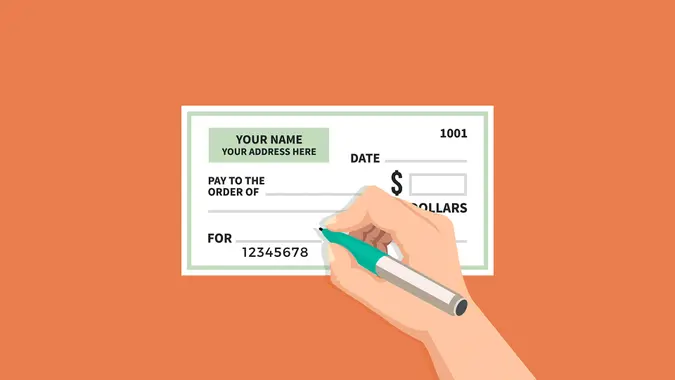Certified vs. Cashier’s Check: What Sets Them Apart?

Commitment to Our Readers
GOBankingRates' editorial team is committed to bringing you unbiased reviews and information. We use data-driven methodologies to evaluate financial products and services - our reviews and ratings are not influenced by advertisers. You can read more about our editorial guidelines and our products and services review methodology.

20 Years
Helping You Live Richer

Reviewed
by Experts

Trusted by
Millions of Readers
When you buy a big-ticket item like a car or make a large payment, such as a down payment on a house, you may be asked to pay with a certified check or a cashier’s check. These checks are less likely to bounce than standard personal checks and are safer than carrying cash.
While these two types of checks seem very similar, a key difference is that the funds from a certified check come directly from the account holder’s bank account, whereas the funds from a cashier’s check are drawn from the bank’s own account.
What Is a Certified Check?
A certified check is a personal check guaranteed by the issuing bank, which verifies that sufficient funds are available and earmarks them for payment to ensure security and trust for the transaction.
Certified checks are used for private sales that involve cars, jewelry or other expensive personal items.
What Does the Bank Do?
The bank’s role in issuing a certified check involves the following three items:
- Confirmation of identity: The bank confirms your identity and ensures your signature is valid.
- Verification of funds: The bank verifies that you have the funds you are requesting for the certified check, ensuring that the payment doesn’t bounce.
- Holding funds: The bank earmarks the specified funds so they aren’t used elsewhere.
Common Ways Certified Checks Are Used
Here are the common scenarios where certified checks are used:
- Higher value purchases: Certified checks can be used to pay for jewelry, cars and other expensive items from private sellers.
- Real estate transactions: You can use certified checks for down payments or to pay closing costs because it builds trust whether you’re the buyer or seller.
- Security deposits: A certified check can be used for a security deposit for an apartment, equipment or another type of rental.
- Court-ordered payments: Legal settlements or bail payments may require a certified check.
- Business transactions: When trust needs to be established immediately, a certified check can be used for business transactions.
What Is a Cashier’s Check?
A cashier’s check is a check issued by a bank or credit union and is drawn from its own account instead of the depositor’s account. To get a cashier’s check, you must visit a bank branch or request one through the bank’s website. The bank will move the money for the check from your account to the bank’s account. Then it issues the check from its account.
Cashier’s checks involve large transactions like a down payment on a home, business deals or other transactions that require large amounts of money.
What the Bank Does
The bank has three key roles in issuing a cashier’s check. Those roles are:
- Funds guarantee: The bank removes the specified amount from your account or accepts cash upfront to guarantee the funds will be paid to the recipient (payee).
- Issuer and payor: The bank is the issuer and payor of the cashier’s check. This reduces the incidence of fraud.
- Security features: Cashier’s checks often have special watermarks and security features that distinguish it from other forms of payment.
Common Scenarios Where Cashier’s Checks Are Used
Here are common scenarios where cashier’s checks are used:
- Large purchases: You can use it to buy large purchases, ensuring that the payee has secured and guaranteed payment.
- Real estate transactions: Down payments, closing costs and earnest money deposits can be paid in real estate transactions.
- Paying debt: Loan payoffs or tax obligations are also ways in which a cashier’s check can be used to settle large debts.
- Legal or business transactions: Cashier’s checks can be used in legal or business transactions to ensure availability of funds.
- International transactions: Some international transactions require the use of a cashier’s check.
Key Differences between Certified Check and Cashier’s Check
There are key differences between a certified and a cashier’s check. Here’s a chart of the differences in source of funds, fees and costs, availability and accessibility.
| Feature | Certified Check | Cashier’s Check |
|---|---|---|
| Source of Funds | Funds come from the account holder’s personal account, verified and held by the bank. | Funds come from the bank’s account after being withdrawn or paid by the customer. |
| Fees and Costs | $5 to $15 depending on the bank. | $10 to $20 (or more) depending on the bank. |
| Availability and Accessibility | Available only to account holders; requires visiting the branch in most cases. | Available to anyone (account holders or not), depending on the bank; some offer online issuance. |
| Security Features | Includes a stamp or certification from the bank verifying funds and account holder signature. | Includes watermarks, unique serial numbers and the bank’s official seal for added security. |
| Fraud Risks | Moderate risk of fraud if the check is forged; verify authenticity before accepting. | Lower fraud risk compared to certified checks, but counterfeit cashier’s checks can still exist. |
Certified Check vs. Cashier’s Check: When To Use Each
You may wonder when it is best to use a certified check or a cashier’s check. Both forms of checks are acceptable forms of payment.
Certified checks may be best for smaller personal transactions under the following circumstances:
- Transactions requiring personal verification
- Smaller or private sales
- When cost is a concern (certified checks are usually cheaper than cashier’s checks)
- In established relationships
Cashier’s checks are ideal in larger transactions under the following scenarios:
- High-value transactions
- Legal and business settlements
- Debt payoffs
- When the relationship is unfamiliar
- When security is critical
- When immediate credibility is needed
- For certain international transactions
What’s Required To Certified and Cashier’s Checks?
Both certified and cashier’s checks require accurate information, including the amount, payee information and issuing bank information. Unauthorized alterations will void both checks.
How To Get a Certified Check
To obtain a certified check, you must follow these steps:
It is a good idea to verify that your bank issues certified checks before making an in-person visit. If your bank issues certified checks, you will likely follow these steps:
- Write the check. Write a personal check indicating the amount of the certified check.
- Go to your bank. Take the personal check to the issuing bank where you have an account.
- Verifying the account. The bank will confirm your identity and verify that your account has a sufficient amount to cover the amount of the check. If the amount is available, the bank will put a hold on the specified funds.
- Stamp of certification. The bank will stamp the check certifying the verification of the amount.
Here are some tips to ensure a smooth transaction:
- Make sure you have sufficient funds in your account prior to going to the bank or credit union.
- Check payee information and the amount of funds requested.
- Bring proper identification.
- Plan ahead as some banks require advance notice.
- Get a receipt for your transaction.
How To Get a Cashier’s Check
Most banks and credit unions issue cashier’s checks. Here is how cashier’s checks are issued:
- Visit your bank or credit union. Visit the bank or credit union who issued your account. Some banks may offer cashier’s checks online.
- Provide specific details. Let the bank know the amount of the check and the payee’s name (the person who is receiving the cashier’s check).
- Payment to the bank. You can either provide a check or ask the bank to withdraw the amount from your account. The bank will verify that you have the funds to cover the amount requested.
- Bank issues the check. The bank issues the check in the amount requested and is the guarantor of the funds.
Fees on cashier’s checks vary from bank-to-bank, but generally cost $10 to $20 or more.
What Do You Do if You Lose Your Cashier’s Check
Losing your cashier’s check is an inconvenience and you need to act quickly once you realize it’s gone:
- Notify the issuing bank immediately.
- Complete a declaration of loss.
- Provide identification and evidence.
- Request a replacement and refund.
- Pay the replacement fee.
Pros and Cons of Certified Checks
Certified checks have advantages and disadvantages. Although there are certain disadvantages, the pros seem to outweigh the cons for smaller transactions. This s a trusted payment method for most people and also more affordable than a cashier’s check.
Advantages
- Guaranteed payment: Ensures funds are available because banks verify funds.
- Trusted by recipients: This form of payment is widely accepted by most individuals.
- Affordable: Certified checks are more affordable than cashier’s checks.
- Fraud prevention: Has a stamp by the bank as a protection from fraud.
Disadvantages
- Account holder limitations: Only account holders at issuing banks can request a certified check.
- Requires an in-person visit: Certified checks need to be purchased at a branch.
- Replacement process: If the certified check is lost, it may require a lengthy replacement process.
- Expiration: Certified checks may expire between 90 to180 days depending on the bank’s policy, which could cause issues for the payee.
Pros and Cons of Cashier’s Checks
Cashier’s checks have advantages and disadvantages. Even though the cost of a cashier’s check is more than a certified check, it is generally more available at banks. Here are some of the pros and cons:
Advantages
- Guaranteed funds: Funds are drawn on the bank so there is guaranteed payment.
- High security: Watermarks and other security are present on a cashier’s check.
- Widely accepted: Trusted for higher value transactions like real estate closings and business deals.
- No account needed: Some banks allow non-customers to purchase cashier’s checks.
- No risk of bouncing: There is no risk of insufficient funds with a cashier’s check.
Disadvantages
- Higher fees: Cashier’s checks cost more than certified checks.
- Risk of loss: Losing a cashier’s check may involve a lengthy process in replacing it.
- Susceptible to counterfeiting: Counterfeit cashier’s checks exist so recipients may have to verify authenticity.
Certified Check vs. Cashier’s Check: Fraud Prevention Tips
Cashier’s checks and certified checks may be safer than personal checks, but scammers also use them. Knowing what to expect can help you protect yourself against scammers. According to the Federal Trade Commission and the American Bankers Association, the following scams are common:
- You’re told that you won a prize and receive an advance on the winnings. You later find out that you need to pay for taxes, shipping and handling, or processing fees, or that you received an excess amount of money that needs to be returned. Not only will you lose the “prize” money, but you’ll also lose the fees you sent.
- Someone pays for an item or service with a fake certified or cashier’s check and will overpay. When you discover that the check amount is too high, the fraudster will ask you to return the excess funds.
- You get hired as a mystery shopper and are paid with a counterfeit bank check. The person who hired you then sends you another check to cash against your account and tells you to wire the funds using a money transfer business to evaluate its services.
In all of these cases, the scammers hope that your bank won’t discover the check is fraudulent until after your funds clear the scammer’s account. The FTC warns that if you deposit a fraudulent check into your account, the bank can come after you for the money when it doesn’t clear.
Precautions Against Check Fraud
Here are some precautions you can take to avoid being the subject of a fake check scam:
- Make sure the bank listed on the check is real. If you’re unsure, you can use the FDIC’s BankFind Suite to verify its legitimacy.
- Call the bank to ensure the check is legitimate. But get the bank’s phone number from its website — don’t use the number on the check in case it’s fake.
- If you weren’t expecting to receive the money, be on high alert and automatically assume the check is counterfeit.
- When the amount on a check is higher than expected, don’t refund any money without first verifying the check’s validity.
- Look for signs that the check may be fraudulent, including smeared colors, spelling errors in the name or address or an MICR number that doesn’t match the check number.
Conclusion
Certified and cashier’s checks are both acceptable forms of payment. You may choose one over the other depending on the transaction. For smaller transactions, a certified check may be the preferred form of payment, while for larger transactions, recipients may request a cashier’s check. Both forms are more secure than a personal check and have security markings to indicate their authenticity.
Certified Check vs. Cashier's Check FAQ
Take a look at the answers to some frequently asked questions about certified checks vs. cashier's checks.- How long does it take for a certified check to clear?
- Generally a certified check clears faster than a personal check. In many cases, the funds are available for the payee within one business day after the deposit.
- What is the maximum amount for a cashier's check?
- The policy on upper limits may differ from bank to bank, but generally there is no maximum amount for a cashier's check.
- What costs more -- a cashier's check or a certified check?
- Cashier's checks have higher fees than certified checks.
Allison Hache and Valerie Smith contributed to the reporting for this article.
Our in-house research team and on-site financial experts work together to create content that’s accurate, impartial, and up to date. We fact-check every single statistic, quote and fact using trusted primary resources to make sure the information we provide is correct. You can learn more about GOBankingRates’ processes and standards in our editorial policy.
- Electronic Code of Federal Regulations. 2023. "Part 229 — Availability of Funds and Collection of Checks (Regulation CC)."
- Federal Trade Commission. 2022. "How To Spot, Avoid, and Report Fake Check Scams."
- American Bankers Association. "Fake Check Scams."
- Georgia Department of Banking and Finance. "Check Fraud / Counterfeit Checks."
- First Republic Bank. 2022. "What Is a Certified Check?"
- Chase. "What is a cashier’s check?"
 Written by
Written by  Edited by
Edited by 

























